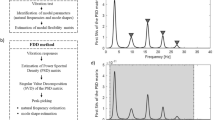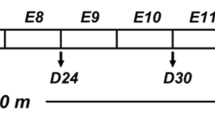Abstract
Structural damage will change the dynamic characteristics, including natural frequencies, modal shapes, damping ratios and modal flexibility matrix of the structure. Modal flexibility matrix is a function of natural frequencies and mode shapes and can be used for structural damage detection and health monitoring. In this paper, experimental modal flexibility matrix is obtained from the first few lower measured natural frequencies and incomplete modal shapes. The optimization problem is then constructed by minimizing Frobenius norm of the change of flexibility matrix. Gauss–Newton method is used to solve the optimization problem, where the sensitivity of flexibility matrix with respect to structural parameters is calculated iteratively by only using the first few lower modes. The optimal solution corresponds to structural parameters which can be used to identify damage sites and extent. Numerical results show that flexibility-based method can be successfully applied to identify the damage elements and is robust to measurement noise.







Similar content being viewed by others
References
Bernal D 2002 Load vectors for damage localization. J. Eng. Mech., ASCE 128(1): 7–14
Bernal D 2006 Flexibility-based damage localization from stochastic realization results. J. Eng. Mech., ASCE 132(6): 651–658
Dharap P, Koh B H and Nagarajaiah S 2006 Structural health monitoring using ARMarkov observers. J. Intell. Mater. Syst. Struct. 17(6): 469–481
Doebling S W 1995 Measurement of structural flexibility matrices for experiments with incomplete reciprocity. Ph.D. Thesis, University of Colorado, Department of Aerospace Engineering Sciences
Doebling S W, Farrar C R, Prime M B and Shevitz D W 1996 Damage Identification and health monitoring of structural and mechanical systems from changes in their vibration characteristics: A literature review. Research Rep. No. LA-13070-MS, ESA-EA, Los Alamos National Laboratory, NM
Farrar C R and Cone K M 1995 Vibration testing of the I-40 bridge before and after the introduction of damage. Proc. 13th Int. Modal Anal. Conf. 1: 203–209
Jaishi B and Ren W 2006 Damage detection by finite elment model updating using modal flexibility residual. J. Sound Vibr. 290(1–2): 369–387
Kammer D C 1991 Sensor placement for on-orbit modal identification and correlation of large space structures. J. Guidance 14(2): 251–259
Koh B H, Dharap P, Nagarajaiah S and Phan M Q 2005 Real-time structural damage monitoring by input error function. J. Amer. Inst. Aeronautics Astronautics, AIAA 43(8): 1808–1814
Liu P 1995 Identification and damage detection of trusses using modal data. J. Struct. Eng., ASCE 121(4): 599–608
Pandey A K and Biswas M 1994 Damage detection in structures using changes in flexibility. J. Sound Vibr. 169(1): 3–17
Ren W and Roeck G D 2002 Structural damage identification using modal data. I: simulation verification. J. Struct. Eng., ASCE 128(1): 87–95
Ricci S 2000 Best achievable modal eigenvectors in structural damage detection. Exp. Mech. 40(4): 425–429
Shi Z Y, Law S S and Zhang L M 2000a Damage localization by directly using incomplete mode shapes. J. Eng. Mech., ASCE 126(6): 656–660
Shi Z Y, Law S S and Zhang L M 2000b Optimum sensor placement for structural damage detection. J. Eng. Mech., ASCE 126(11): 1173–1179
Sohn H, Farrar C R, Hemez F M, Shunk D D, Stinemates D W and Nadler B R 2003 A review of structural health monitoring literature: 1996–2001. Los Alamos National Laboratory Report, LA-13976-MS
Udwadia F E 2005 Structural identification and damage detection from noisy modal data. J. Aerospace Eng., ASCE 18(3): 179–187
Wu D and Law S S 2004 Model error correction from truncated model flexibility sensitivity and genetic parameters: Part I—simulation. Mech. Syst. Signal Process. 18: 1381–1399
Zhang O and Zerva A 1996 Iterative method for calculating derivatives of eigenvectors. AIAA J. 34(5): 1088–1090
Zhao J and DeWolf J T 1999 Sensitivity study for vibration parameters used in damage detection. J. Struct. Eng., ASCE 125(4): 410–416
Acknowledgments
The authors thank the support of the Texas Institute for the Intelligent Bio-Nano Materials and Structure for Aerospace Vehicles, funded by NASA Cooperative Agreement no. NCC-1-02038.
Author information
Authors and Affiliations
Corresponding author
Rights and permissions
About this article
Cite this article
CHEN, B., NAGARAJAIAH, S. Flexibility-based structural damage identification using Gauss–Newton method. Sadhana 38, 557–569 (2013). https://doi.org/10.1007/s12046-013-0151-3
Received:
Revised:
Accepted:
Published:
Issue Date:
DOI: https://doi.org/10.1007/s12046-013-0151-3




